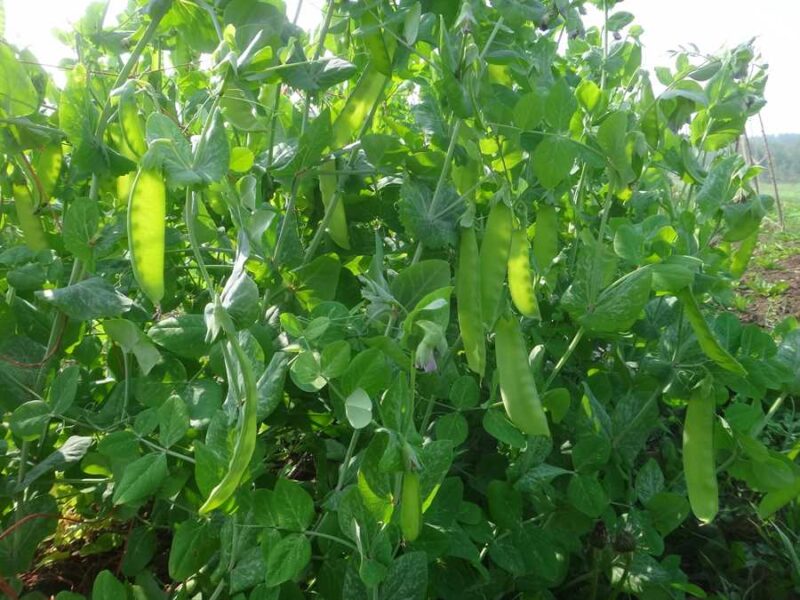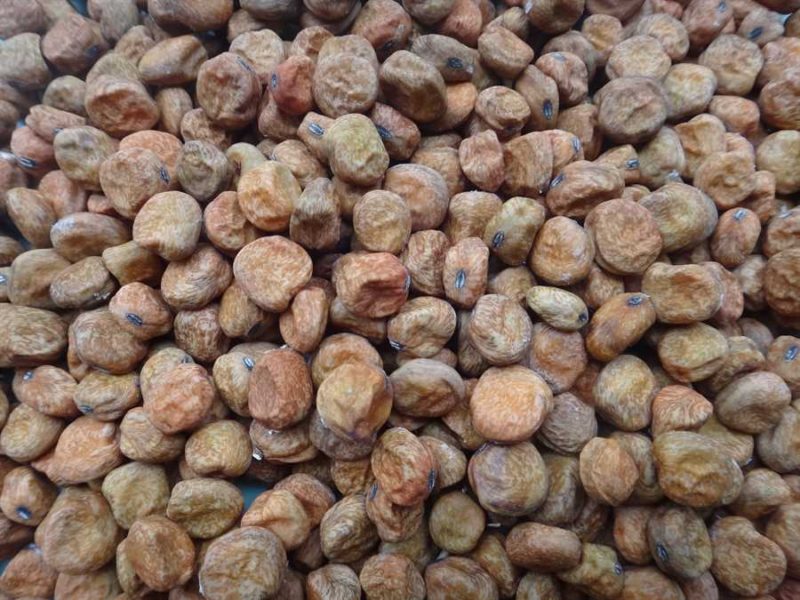(Pisum sativum)
Peas have a very long history alongside humanity; they may have been domesticated as much as 13,000 years ago. All that time has let us do some interesting things with them. Today, we eat peas at the same three stages as beans, though we call these stages by different names. Snow peas are analagous to green beans, eaten while the seeds are still undeveloped and pods are flat. Shelling (also called green or garden) peas are eaten by shelling them out of their pods when the seeds are full-sized but still green. If seeds are left until the pods are dry and fully mature, you get dry peas. Different varieties are best for different purposes.
I trellis most of my peas, using either old page-wire fence or nets I make out of baler twine. I have also heard that chicken wire or hex-wire works well. Trellising is not vital for the peas to grow; however, it makes picking much easier, and if you are growing dry peas, decreases the risk of mold if there is rain late in the season.
-
- Out of Stock
Carouby de Maussane pea
- $4.00
- (Pisum sativum) An old French heirloom, this variety impressed me for its enormous (5”/12.5cm), tender pods which, unlike many snow peas, stay tender and actually get sweeter as the seeds swell. I have heard of this pea reaching 4’/1.2 m in height or more; for me it only reached 2’/60 cm but still produced abundantly. However tall it grows for you, you will get better quality pods if you trellis…
- Read more
-
-
Edna’s Russian pea
- $4.00
- (Lathyrus oleraceus syn. Pisum sativum) A sugar pea (i.e. eat the whole pods). Vines about 4’ tall are loaded with medium-sized pods about 3-4” long and ¾” wide. Pick when seeds are swelling but before they are at the shelling stage; a slightly more solid and filling pea than the true carouby types like Schwiezer Riesen. This variety produces a large flush of pods all at once which dry down…
- Add to cart
-
Japanese Snow pea
- $4.00
- (Lathyrus oleraceus syn. Pisum sativum) A carouby (giant snow) pea with enormous, sweet pods – the largest and sweetest we have found, about 5” long by 1” wide! Abundant, covers a 5’ trellis. We eat loads of these in season.
- Add to cart
-
Schweizer Riesen pea
- $4.00
- (Lathyrus oleraceus syn. Pisum sativum) Carouby (giant snow) pea with bright light green pods of extraordinary width. Unlike some snow peas, the pods do not toughen the instant the seeds begin to swell; in fact, they become sweeter! So let them thicken a bit before picking. Our family waits for these each year with eager expectation. The name means “Swiss Giant” in German; Switzerland being a multilingual country, poised on…
- Add to cart
-
Fairbank pea
- $4.00
- (Pisum sativum) 4’/1.2 m tall with white flowers, this is a delightful shelling pea with small pods. I received this variety from Edith Martin of Durham, Ontario, so it is well adapted to our area. I have not been able to find any information about the history of this pea before it reached our area; there is a neighbourhood of that name in Toronto, and a provincial park with the…
- Add to cart
-


Green Arrow pea
- $4.00
- (Pisum sativum) The shelling pea for many pea growers. Long pods on short bush plants makes growing and harvesting them easy, and their flavour is hard to beat. 40 seeds/packet.
- Add to cart
-
Alaska pea
- $4.00
- (Pisum sativum) 3’/1 m tall. Prolific producer of small pods, which make good shelling peas but really excel as a dry pea. Round, green seeds’ only disadvantage is that if you drop them they will roll a long ways! Alaska was released in 1881 in England as ‘Earliest of All’ by Thomas Laxton, the legendary pea and strawberry breeder. It was brought to the United States shortly after, and soon…
- Add to cart
-
Capucijner pea
- $4.00
- (Pisum sativum) Capicijner - 5’/1.6 m tall. Our most ornamental pea, and a staple in our family cuisine as a dry pea. Pink flowers are followed by distinctive purple pods, for which reason they are sometimes called Kapucijner Blauwschokker, the Blue-Podded Capucijner, in their native Dutch. Dry seeds are large, wrinkled, and olive-green. They hold their shape when cooked, tasting and appearing rather like chickpeas (but they're much easier to…
- Add to cart
-
Capujineer pea
- $4.00
- (Pisum sativum) 8-12”/20-30 cm tall. Like Capucijner, this pea is also from the Netherlands, and comes with the same story of having been grown by the Capuchin monks. However, these are dwarf plants with green pods and large green seeds with beautiful brown speckling. This variety is locally adapted; I received this pea from Edith Martin, a friend and far more experienced gardener who lives near Durham, Ontario, and who…
- Add to cart
-
Dead Viking pea
- $4.00
- (Lathyrus oleraceus syn. Pisum sativum) A pretty, 5’ tall pea with pink flowers and tiny, speckled, dark seeds. I acquired this variety from Revival Seeds, who received it from a friend from Oslo, Norway. According to them, it strongly resembles the peas found in Scandinavian burial mounds from 800 AD or so. It is, of course, hard to be sure over such a span of time that this is the…
- Add to cart
-
Flamische Riesen Schnabel pea
- $4.00
- (Pisum sativum) 5’/1.5 m tall. A dual-purpose shelling/dry pea with round, pale yellow seeds. Early, pretty, and a great name – translates as “Flemish Giant Beak” (a reference to pod shape, I presume?). A rare variety I got from Le Potager Ornemental in Quebec; they received it from Will Bonsall in 2018. I can find almost no other information about it, except one detail. It was received on April…
- Add to cart
-
- Out of Stock
Gold Harvest pea
- $4.00
- (Pisum sativum) A plant of extremes: our shortest bush pea, with the largest peas in our collection. Its colours are also interesting: the flowers are red and white, and the wrinkled seeds are gold, of course (but I would have called it orange), with brown speckling. 100 days to maturity. 35 seeds/packet.
- Read more
-
-
Golderbse pea
- $4.00
- (Lathyrus oleraceus syn. Pisum sativum) I am excited about this pea! About 5’ tall, with high yields of small, round seeds, which are patterned in yellow with a slightly translucent quality I have never seen before, making them seem to glow. I find the diversity of the peas, dry peas especially, quite wonderful. This pea also has an interesting history. William Woys Weaver believes it to be the same as…
- Add to cart
-
Lollandske Rosiner pea
- $4.00
- [Lathyrus oleraceus syn. Pisum sativum] A landrace dry pea growing on short, bush-type plants. These peas are semi-leafless; this means that some leaves have been replaced by extra tendrils, making the plants cling to each other and not require trellising. Large, wrinkled olive-coloured seeds. The name ‘Lollandske Rosiner’ translates as ‘Lolland Raisin’; and indeed the seeds somewhat resemble raisins in appearance and the variety is still grown on Lolland and…
- Add to cart
-
St. Hubert’s pea
- $4.00
- (Pisum sativum) 5’/1.6 m tall. An old French-Canadian pea with small, round, green seed. The ancestors of this pea were brought to the St. Lawrence valley in Quebec by settlers 300 or more years ago. Apparently a favourite for hunters, who used it for soup; its name is a reference to St. Hubertus, who, legend has it, was hunting a stag on Good Friday in 684 when he had a…
- Add to cart
-
Tjörn pea
- $4.00
- (Pisum sativum) A 5'/1.6 m tall ''grey'' pea. Large, olive-green wrinkled seeds with distinctive dark hila. Matures about 3 weeks later than most dry peas, and therein lies a sort of long story, so please make sure you are settled comfortably before reading on. For my personal diet, I divide dry peas into two classes: grey (large wrinkled seeds that retain their shape when cooked and are used more like…
- Add to cart
-
Wild Pea of Umbria
- $4.00
- (Pisum sativum) 3-5’/1-1.6 m tall. This delightful little pea is a landrace from Umbria in the Apennine mountains of central Italy, where it is called “roveja” or “roveglia”. It has grown in that area for centuries certainly, millenia probably; some say that humans started foraging it there during the Neolithic, and later domesticated it. If so, it may show us what the ancestors of all our other peas looked like.…
- Add to cart

















